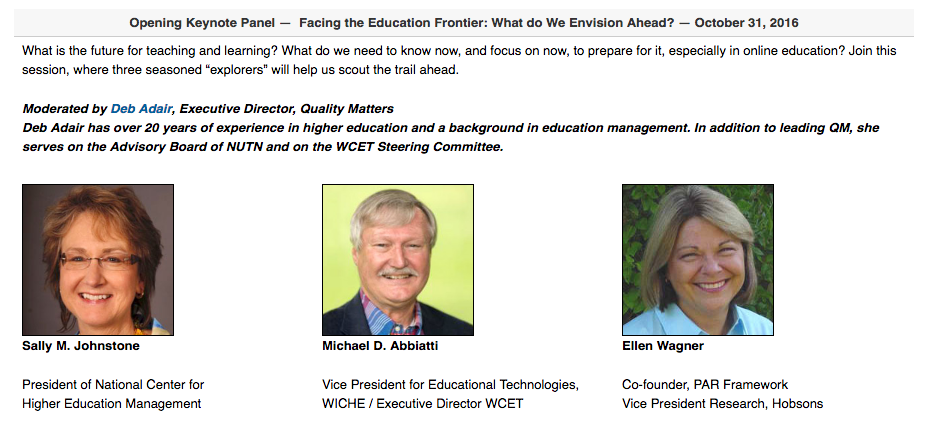Last week the person the Quality Matters Twitter account direct messaged me three questions. They said, “We want to know what YOU think! Help set the stage for our intrepid, seasoned panelists who will engage with a set of questions about our future and your own responses to these questions.” Nice. It would be good for the speakers to have some ideas about the interests and concerns of the people they are talking to.

I wondered what that looks like in classrooms. I suppose it is the teachers asking a “Why are you here?” sort of question at the outset of the course. I like that. It is good to know who wants to go where, and why.
I think these are good questions to wonder about. I will share the questions and my answers here for this post.
Q1: What is YOUR vision of the future for teaching and learning? What’s the prize we are looking for – once we get where we are going?
That teaching and learning will be engrained within the community and the roles of students and teachers become blurred into the many roles people play in communities. Students will be responsible for doing important tasks within our communities. There will be more adventure. Not just adventure of the brain, but of the body. Of the soul. Schooling will become messier. It will be harder to define lines between the “school” and “life.” Fewer people will say, “When I get out into the real world…” There will be more teachers because the profession will become one that many aspire to be a part of. For many reasons. But the schools themselves, the buildings and “things” of school, will become more engrained in the way communities function.
We are looking for people who have a broad range of experiences behind them and know how to place themselves in places that make them work. Make them think. And make them questions their existing ideas. Not just people who know stuff, but people who can imagine things and have the desire to make those things realities.
We are going to create healthy and happy people. People who have confidence in their capabilities. People who are honest and hard working. People who want to be more and are capable of getting it.
Q2: What will that path look like? What should we expect to see?
Students and schooling will become more visible. You will see them outside of school buildings more often. The “students” will play larger roles in doing things that are necessary for communities to function. They will be given work in school that requires more than mental effort. It will require physical effort and lots of it.
— on a side note here, I am sort of reminded of our current infatuation and longing for qualities like “grit” and “perseverance” and “completion” and how we assess those things simply by the quantity of numbers/letters on a piece of paper. There are better ways to learn how to keep going. The world is full of opportunities to literally dig into or walk though spaces that challenge our endurance. That make us sweat and work for a goal. Largely, we have reduced those options to some test scores.
Anyway, in the future, when schooling is on a more amazing path, we will find that we have created in students a resource for our community. One that contributes directly to our shared daily life beyond amassing piles of worksheets and PowerPoint files. The students and teachers will be doing “service learning” every day. They will find mentors in adults in the community and create relationships that bridge the age lines we drew with social promotion as the only indicator of capacity. Students will be away from home more often. They will travel to places to touch the things they currently only read about. There will be more field trips.
Q3: What obstacles can we expect along the way?
Our history.
Not that what we have accomplished is nothing short of miraculous, but that we have made errors and that we must be willing to remedy them. That will take more advocacy from parents, teachers, and local communities and federal and state government. That of course, will take time.